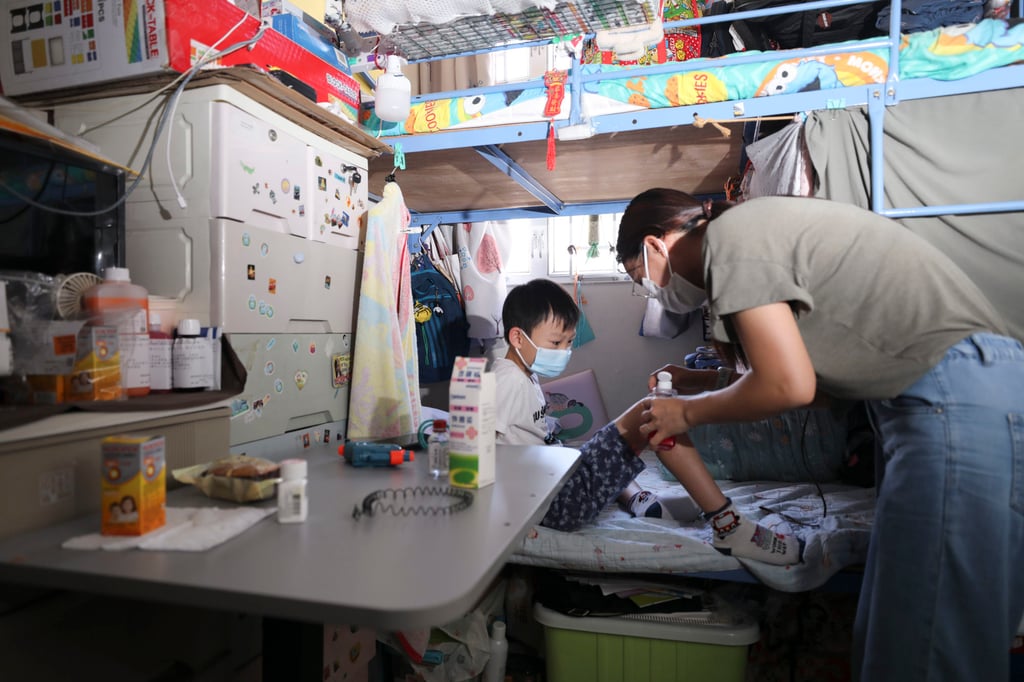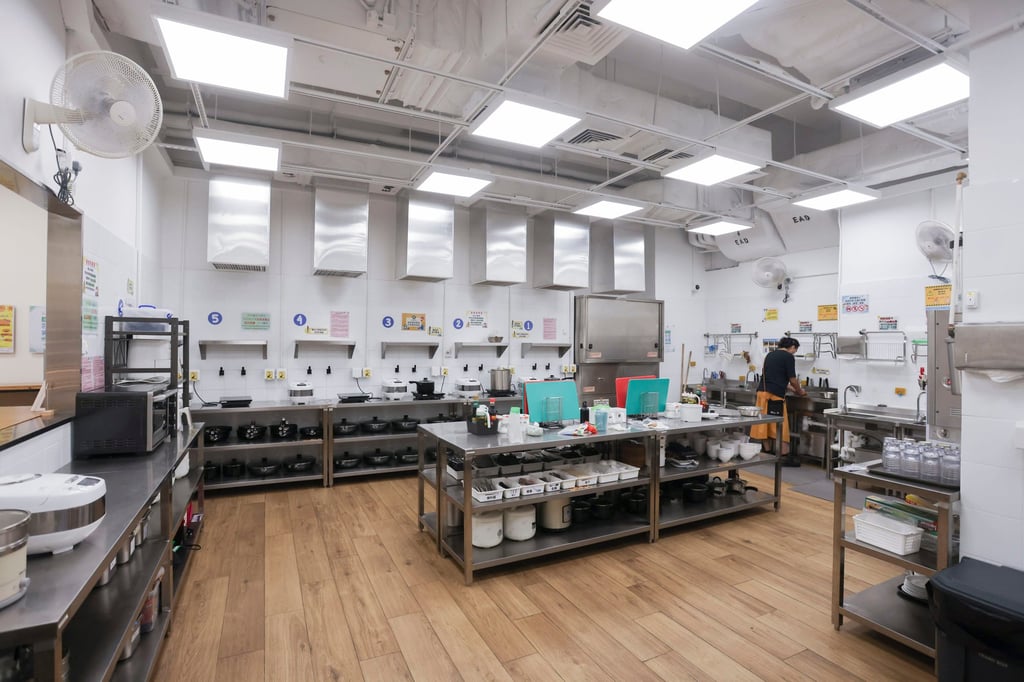Hong Kong’s tiny subdivided homes, notorious for poor living conditions, are expected to be regulated after the city leader looks at a proposal from a cross-departmental task force this month.
In the last of a three-part series, Edith Lin and Vivian Au look at how the quality of life can be improved for people who continue living in such homes. Read the first part here and the second here.
Hong Kong homemaker Ng Yuk-fung’s life changed in many ways after a “community living room” opened last November just 10 minutes from her subdivided flat in Tsuen Wan.
Home for Ng, her husband and eight-year-old son was a 100 sq ft space, where they could only sit on the bed, and swelter in the summer heat to save on electricity costs from switching on the air conditioner.
She had only a single electric stove for cooking, and hung the laundry to dry indoors or on their building’s rooftop.
Since November, Ng and her son, Alvin Leung Wing-tung, have been regular visitors to the 3,000 sq ft community living room run by NGO Caritas Hong Kong for tenants of subdivided homes.
It is fully air-conditioned, has sofas and a television set, a communal kitchen with 12 stoves, two ovens and two refrigerators, and a laundry area with washing and drying machines.
Everything is free of charge.
Ng, 39, has made friends with other tenants preparing meals together in the kitchen. Alvin, who has attention deficit hyperactivity disorder and always grumbled he had nobody to play with, began mixing with other children and his social skills improved.
“I had a hard time taking care of him as he doesn’t listen to me,” she said. “We often hurt each other with words and anger, but now he has learnt to keep calm and apologises when he knows he is in the wrong.”
Ng said she was less stressed herself. She no longer quarrelled like before with her husband, the family’s breadwinner, who is 41 and works in the logistics industry.
The idea of community living rooms came from social workers serving people living in cramped, small spaces such as Ng and her family, and aimed to provide them more room to do their chores, take a break, meet other people and explore their potential.
Aside from the Caritas centre and other similar “extended living spaces” run by NGOs, the government has provided HK$100 million (US$12.9 million) government funding and invited NGOs to run four projects at sites offered by private developers in Sham Shui Po, Nam Cheong, To Kwa Wan and Hung Hom, ranging from 2,200 sq ft to 6,900 sq ft, serving at least 1,750 households.
With housing minister Winnie Ho Wing-yin hinting that Hong Kong will continue to have subdivided flats even after proposed regulations for such homes take effect, social service advocates said the community living room idea should stay and be transformed in their size and the range of services.

Centres’ bathrooms a big relief
Last December, the first government-led community living room opened on the first floor of a private residential building owned by developer Sino Group at Fuk Wa Street in Sham Shui Po.
The operator, the Lok Sin Tong Benevolent Society, Kowloon, received HK$26.75 million to run the 4,300 sq ft space for three years, exempted from paying rent and rates.
Word went around quickly that there was a new community space meant to improve the tenants’ quality of life. Sham Shui Po had 22,153 subdivided flat households, as of the 2021 census.
Within half a year, the centre hit the government target of serving 500 families a year.
Centre chief Chui Wui-chung said some facilities were almost fully booked from 4pm to 8pm on weekdays, as many families headed there after school and work.
The popular services included the two bathrooms with showers that could be booked for 30-minute sessions.
Chui said the showers were popular as some subdivided flat tenants wanted to stay cool during summer, while others were concerned about hygiene from having to share a bathroom with other tenants at their subdivided flats.
Also well-used was the kitchen, equipped for up to eight families to cook at the same time. The 600 sq ft living room and the dining hall which seats 70 also filled up quickly on weekday evenings.
Chui said his team had created spaces for different age groups and extended bathing hours in the afternoon to encourage the elderly to come earlier.
“We can offer the most comfortable environment for 500 families in the space we have now,” he said.
He added that the area, one of the poorest in Hong Kong, needed more such centres.
“If the community living rooms are dispersed in different areas of Sham Shui Po, they will be more accessible to residents,” he said.
He said the centre would work with another community living room 15 minutes away, and also hoped to collaborate with other sectors including healthcare services providers to meet residents’ needs.
Idea took years to become reality
Senior social work supervisor Kenneth Pang Che-chung, who initiated the Caritas community living room project in Tsuen Wan, is gratified that his hard work has helped improve the lives of the people from 450 subdivided households who use it.
He first thought of the idea of such shared community spaces seven years ago, but it took time before it finally got off the ground.
Even after receiving funding support in 2021, he had trouble finding a venue that was spacious enough.
He eyed a 1,200 sq ft vacant shop, but the funder was put off by the monthly rent of HK$130,000. Pang then came across the empty former staff quarters of the Food and Environmental Hygiene Department on the fourth floor of Tsuen Wan Market.
After negotiating with the authorities and explaining the new idea, his team succeeded in getting the government property for a nominal annual rent of a dollar.
The place was refurbished, and it took HK$2 million a year to run the new centre, which also received donations of home appliances.
“The electricity bills are high as we offer kitchen and laundry services and turn on the air conditioning all the time,” Pang said. “The water bills and maintenance costs too.”
The team organised outdoor activities for the subdivided flat tenants, but could only accept 50 participants at most.
“If we have more resources, we can enrich our activities or have more manpower for activities,” he said.
Pang said government help to overcome barriers was important, as it could free up more idle public space for such centres and encourage private funding to support future operations.
Noting that large vacant spaces were not available in all parts of the city, he suggested opening smaller “satellite extended living spaces”, each offering a single service such as the laundry room, kitchen or activity space.
Public spaces such as parks and vacant shops could be considered for these purposes too, he added.
The Labour and Welfare Bureau told the Post it would continue to encourage active participation from the business sector in providing venues to set up community living rooms in districts with clusters of subdivided flats.
To decide the way forward, it added, the government would review the operations of these centres after a year and examine their effectiveness.
More targeted services to meet needs?
Sze Lai-shan, deputy director of the Society for Community Organisation, which helps poor families, hoped that as more community living rooms opened, their services would match the needs of tenants more closely.
For example, in areas with more young families, the centres could offer babysitting services, she said.
She hoped the government would give priority to adding more living rooms to areas such as Yau Ma Tei, Tsim Sha Tsui and Mong Kok, which had the most substandard flats in 2021, according to official data.
When a government-led centre opened this month at To Kwa Wan in Kowloon City, single mother Sally Zhang* was dismayed that it was too far from her subdivided flat.
Living with her eight-year-old son and parents in a 160 sq ft space, she said they would have to walk at least 20 minutes to get to the new centre.
She was delighted to see another community living room opening in Hung Hom, five minutes from her home, but said even that might be hard to use.
Zhang said she was too busy at work, and her parents could not manage to take her son to the centre. She earned only about HK$9,000 a month working part-time in various sectors including the catering industry.
She wished the centre could provide a pickup service for families such as hers, so she could spend more time getting a stable job.
“I hope to improve our quality of life,” she said.

Tenants learn to use their talents
Social worker Pang from Caritas has not stopped thinking of ways to expand the idea of extending the living space for people from tiny homes.
Aside from meeting their daily needs, he hoped the community living rooms across Hong Kong would become social hubs where people gathered, made friends and learned to use their talents.
“The tenants have many abilities and these are their social capital,” he said.
Homemaker Kimmy Chen recalled how her eyes lit up the first time she saw the spacious, well-equipped kitchen at the Caritas centre in Tsuen Wan.
She loves making snacks for her family, but had only a narrow cooking space in her 100 sq ft subdivided flat.
She had never dreamed of starting a business until the day she volunteered to make her speciality, snowflake crisps, and everyone at the centre praised the crunchy treats.
With the help of the social workers, she registered Kimmy’s Patisserie in May, promoted her brand on social media and was invited to serve her snacks at a charity banquet.
She was delighted when someone who attended the banquet ordered 20 packs. Chen said the joy of earning HK$3,600 for her first order was unforgettable, and that spurred her to develop more than 10 flavours of snowflake crisps.
Chen hoped her fledgling business might help ease the burden on her husband, who works in the catering industry for HK$20,000 a month. They have a daughter, 11, and a son, three.
“It is important that I can handle my responsibility of taking care of my home and developing my career,” she said. “I cherish this opportunity to start a business.”



